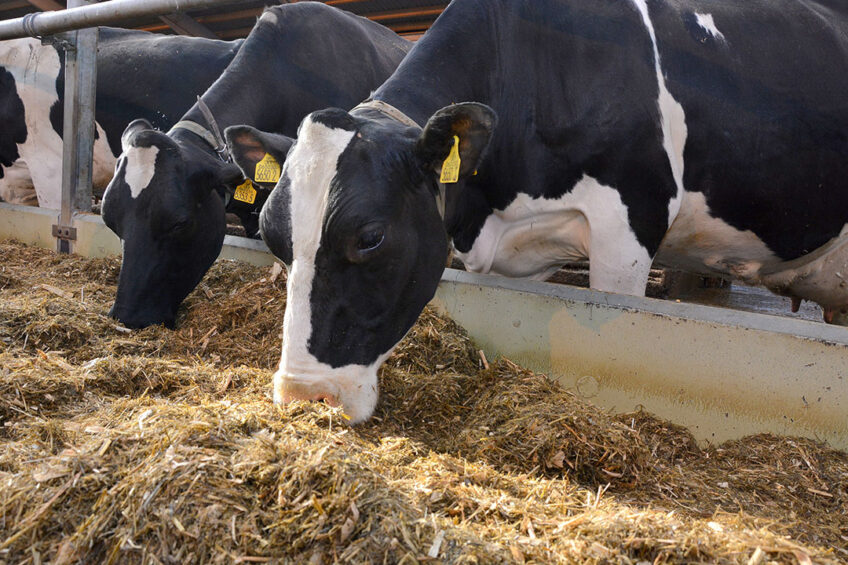Early signs to detect SARA in the herd

Subacute ruminal acidosis (SARA) remains the most important digestive disorder (from a financial perspective) caused by high accumulation of volatile fatty acids (VFA) in the rumen. It is mainly observed in high yielding dairy cows in early and mid-lactation. Here are 4 ways to detect SARA early on.
VFAs in the rumen and the acetic to propionate ratio
Volatile Fatty Acids (VFAs) are the primary energy source for ruminants, mainly produced and absorbed in the rumen. The more soluble and degradable nutrients are, the higher the VFAs production will be, the lower rumen pH drops. When pH drops, rumen epithelium absorption capacity becomes significantly lower.

Feed rations depending on Forages : Concentrate ratio can alter pH because of different levels of nutrient fermentability. Forages have a high proportion of structural carbohydrates (mainly cellulose, hemicellulose), fermented to acidic acid (AA) by cellulolytic bacteria in a rumen pH range between 6-7. Concentrates consist of rapidly fermentable nutrients to propionic acid (PA) such as starch and sugars in a rumen pH range of 5-6, by amylolytic bacteria. AA constitutes almost 60% of total VFAs and is the main precursor for lipogenesis, directly affecting milk fatty acid synthesis in the mammary gland. PA can reach 20% of total VFAs and provides energy through its conversion to glucose in the liver, absorbed in the intestine. PA is the main precursor of lactose, interrelated to milk quantity throughout lactation. The remaining 20% of VFAs refers to butyric, valeric acid etc.
4 Ways for early recognition of SARA in the herd
![]() Rumen AA:PA ratio is often the case where sub-clinical ruminal disorders may be observed
Rumen AA:PA ratio is often the case where sub-clinical ruminal disorders may be observed
The lower the rumen AA:PA ratio is, the longer rumen pH rates 6 or lower. The longer the rumen is exposed to lower pH the more structural carbohydrates fermentation depresses because cellulolytic bacteria significantly lower their activity. Accumulation of acids can damage rumen epithelium resulting in a reduced absorption of VFAs which will further increase their concentration in the rumen. SARA has been characterised as the situation in which rumen experience a pH range of 5.2 to 6 for a prolonged period. Modern barns avail indoor total mixed ration feeding (TMR). TMR uniformity remains a priority in terms of recipe forage : concentrate ratio but also in terms of physical appearance. Evenly cut and mixed feedstuffs can avoid recipe sorting thus promoting a more palatable feed for the cows. Outdoor farming and totally grass-fed cows are more susceptible to acidosis because of forage consumption based on rapidly fermentable grass, low in structural carbohydrates and inconsistent feeding times within the day, interrelated to individual cow behaviour.
 More focus on cow gut health
More focus on cow gut health
Leaky gut syndrome receives a lot of attention. Yet, questions remain about the cause, consequences and treatment of it.
![]() Milk fat depression (MFD) is a fast and accurate way to detect cows with acidosis
Milk fat depression (MFD) is a fast and accurate way to detect cows with acidosis
Milk butter fat can be showed as significantly lower (0.65 – 1%) with daily milk analysis while milk protein remains at normal levels. This affects cheese yield and secondary cheese characteristics, reason being for dairies to overpay milk quality. Although modern mixing wagons physically improve effective fibre in TMRs and nutritional formulation strategies improve feed optimisation, some cows in the herd still experience SARA. This is well described by indicating the existence of inter-animal variation to rapidly fermentable carbohydrates. Milk fatty acids analysis in such cows, characterized by a higher proportion of trans isomers: C18:1 trans-10, C15:0, and C18:1 trans-10 to C18:1 trans-11 ratio.
![]() Excessive rumen nitrogen is a good index for energy : protein ratio imbalance
Excessive rumen nitrogen is a good index for energy : protein ratio imbalance
Ration imbalances further occur after mutual reduction of rumen pH, ammonia and nutrient absorption due to SARA conditions. Cellulolytic bacteria can define almost 80% of metabolizable protein (MP) for cow requirements. The rest – 20% of metabolizable protein provided with rumen undegradable protein (RUP) sources. Overfeeding dietary proteins with low biological value (less essential amino acids) while the ration is poor in rapidly fermentable energy for bacteria, further increases nitrogen losses. Excessive rumen nitrogen circulate in blood (BUN) and milk (MUN) as urea. Ammonia rumen absorption is rapid at a pH of 6.5 or higher. Absorption declines when rumen turns more acidic, elevating ammonia to toxicity levels from its accumulation in the rumen. Synchronization of protein degradation is also associated with the production of VFAs and nutrient flow in the rumen. Rations promoting rumen buffering and anaerobic environment, peptides and co-factors can stimulate further bacterial growth.
 Global approach to rumen microbiome research necessary
Global approach to rumen microbiome research necessary
In recent years, much emphasis has been put on the composition and function of the rumen microbiome and its association with environmental and economically important factors, such as methane emissions.
![]() 4. Monitoring herd indexes starting with dry matter intake (DMI)
4. Monitoring herd indexes starting with dry matter intake (DMI)
SARA is associated with gastrointestinal inflammation progressively promoting fluctuations in cow feeding behaviour, feed intake depression, reduced diet digestibility, liver abscesses, and lameness. With reduced digestibility, mild diarrhoea occurs and metabolic losses expand to negative nutrient balance due to lower absorption. Especially for dynamic nutrients such as trace elements and vitamins, primary deficiencies often associated with low enzymatic activity and increased milk somatic cell count (SCC). Yellowish and foamy faeces, containing undigested grain particles indicate digestion depression and fast feed passage in the gastrointestinal tract. Faecal lipopolysaccharide (L.P.S) concentration (endotoxin from gram-negative bacteria) could also be a SARA index. Locomotion scoring is important as it is believed that chronic laminitis remains a clinical sign of a herd with a SARA problem. Lower reproductive performance is also an index as fertility depressed through prolonged calving to conception intervals. Body condition scoring (BCS), rumen fill scoring (RFS) and manure scoring on a daily basis can give a solid outcome regarding health and welfare status of the cows.
References available on request
Join 13,000+ subscribers
Subscribe to our newsletter to stay updated about all the need-to-know content in the dairy sector, two times a week.










